In the fast-paced digital landscape, the speed of your website can make or break its success. Research shows that 40% of users abandon a website that takes more than 3 seconds to load, while a 1-second delay in page load time can lead to a 7% reduction in conversions. Additionally, search engines like Google consider website speed as a ranking factor, influencing your visibility and organic traffic. As a WordPress site owner, optimizing your site’s speed is crucial for delivering a seamless user experience and achieving your business goals. In this blog post, we will delve into the importance of measuring your WordPress site’s speed, explore the impact of slow-loading sites, and provide actionable strategies to optimize your site for maximum performance.
The Significance of Website Speed:
Website speed is a critical factor that directly influences user experience, conversions, and search engine rankings. Consider the following statistics:
- 47% of consumers expect a web page to load in 2 seconds or less.
- A 1-second delay in page load time can result in an 11% decrease in page views.
- 79% of online shoppers who experience dissatisfaction with website performance are less likely to buy from the same site again.
- Google’s Page Experience update, which emphasizes user experience factors like site speed, has a substantial impact on search rankings.

Proportion of users who expect a website to load within 3 seconds or less.
Factors to Consider When Conducting a Webpage Test
Not all webpage speed tests or tools yield identical results. Therefore, it is crucial to strike a balance between these results and understand which metrics to focus on in order to obtain the most unbiased outcomes.
- Caching
First and foremost, perform tests with caching both enabled and disabled to observe the differences. While many tools typically disregard caching, platforms like WordPress allow you to assess page speeds with caching enabled. Configuring your caching settings will help determine if it impacts your results or distorts them compared to other tools.
2. Location
Many individuals tend to overlook the significance of location when conducting page speed tests. However, load times can vary depending on the user’s network and server proximity in different countries and regions. Some people have significantly reduced their website load times by hosting their site on a server geographically closer to their target audience or by utilizing a content delivery network (CDN) consisting of distributed servers.
3. Running Multiple Tests
Each page speed test may produce different results due to anomalies related to your website or network. Therefore, I recommend running multiple tests using various tools to obtain the most accurate depiction of the user experience.
4. Metrics
Finally, it is crucial to understand the key metrics that significantly impact page load speeds. Here are a few important ones to consider:
a. Page Load Time: This metric measures the total time required to fully load a page. Google Analytics offers a page load time report for each URL, including variations across different browsers.

b. Time To First Byte (TTFB): TTFB measures the time taken for browsers to receive an HTML request from the server. Poor TTFB scores may indicate the presence of large files on your website or the need to switch to a different server.
c. Number Of HTTP Requests: Every time a page needs to load a file, it sends a new request, which can impact page speeds.
d. Core Web Vitals: These vitals consist of three key metrics:

5. Field vs. Lab Data
Differentiating between field and lab data is essential when evaluating page speeds. Field data considers the historical load times of a page, while lab data provides information from simulated tests. Google Analytics offers field data, providing a historical record of average page load times on your site. Conversely, lab data from tools like Google’s Lighthouse provides an approximate measurement of page load speeds under controlled variables. Lab data is useful for identifying specific issues, while field data enables tracking the progress and usability of your website over time.
Top Website Speed Test Tools of 2023:
1. PageSpeed Insights

PageSpeed Insights, developed by Google, is an indispensable tool for webmasters seeking to understand how their site is evaluated by the search engine giant. Originally designed to measure website loading speed, it has evolved into a comprehensive SEO tool with a wealth of valuable recommendations. Regularly used by webmasters, PageSpeed Insights provides a strategic overview of websites.
One of the standout features of PageSpeed Insights is its ability to showcase real-world user experience details. It assesses a website based on Core Web Vitals, which are key metrics that measure how visitors perceive and interact with the site. These metrics include:
- Largest Contentful Paint (LCP): This metric measures the loading performance of the website, specifically the time it takes for the largest content element to become visible.
- First Input Delay (FID): FID measures interactivity by gauging the time it takes for a user’s first interaction to be processed, such as clicking a button or selecting a menu item.
- Cumulative Layout Shift (CLS): CLS measures visual stability and quantifies the amount of unexpected layout shifts that occur during the page load, which can be disruptive to the user experience.
PageSpeed Insights displays these metrics, urging website owners to strive for improvement. By entering your website URL, you receive separate mobile and desktop scores for various key aspects:
- Performance
- Accessibility
- Best Practices
- SEO
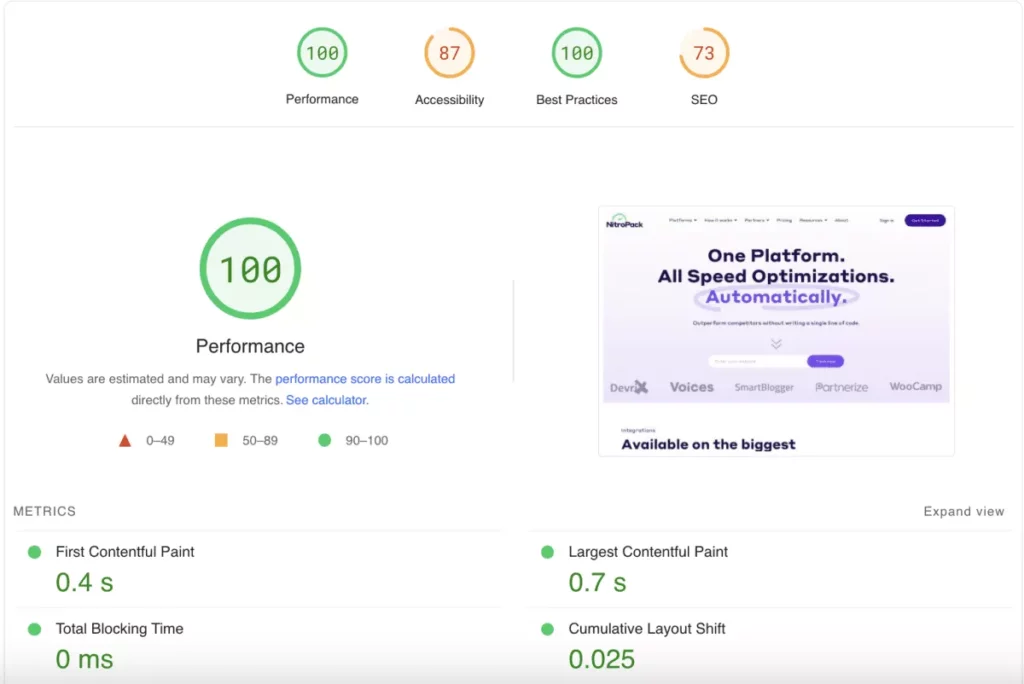
These scores range from 0 to 100. A grade below 49 falls into the red zone, indicating critical issues that require immediate attention. Grades between 50 and 89 are common and suggest room for improvement. Any score above 90 signifies excellent performance and implies that Google recognizes the quality of your work.
Pros:
- Trusted as a Google product
- Simple to use
- Useful suggestions
Cons:
- No possibility to customize the testing conditions
Price: free of charge
2. SuperbThemes Page Speed Checker

The SuperbThemes Page Speed Checker is a user-friendly and effective tool that caters to users of all experience levels. Whether you’re accessing it on a mobile device or desktop, there’s no need for registration or limitations.
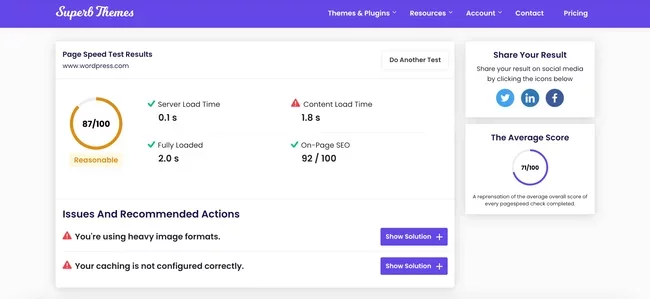
While this tool may not provide in-depth advanced recommendations, it offers everything you need to form an accurate first impression of a website. It evaluates your site and provides insights into its performance, including:
- Server load time
- Content load time
- Fully loaded time
- On-page SEO assessment
Based on these metrics, the page checker assigns a rating to your website on a scale from 0 to 100.
What sets the SuperbThemes page checker apart is its emphasis on practical solutions rather than presenting complex recommendations. You won’t need to spend time deciphering technical advice. Instead, the tool suggests straightforward yet effective remedies, such as installing a plugin or transitioning to a more efficient hosting platform.
For example, if a tested website exhibits slow hosting load times, the SuperbThemes page checker highlights this issue and suggests alternative solutions like A2 Hosting or Pressable.
With just 30 minutes of your time, you can significantly enhance your website’s performance. Not only is it simple to use, but it also saves you time by eliminating the need to search for the right plugins or read numerous articles.
The SuperbThemes team comprises skilled WordPress enthusiasts, and their solutions are backed by their expertise. It’s like receiving guidance from professionals, and it’s available to you free of charge!
Pros:
- Simple to use
- Focuses on practical solutions
Cons:
- Not suitable for comprehensive site assessments
Price:
- Free of charge
- No registration required
3. GTmetrix
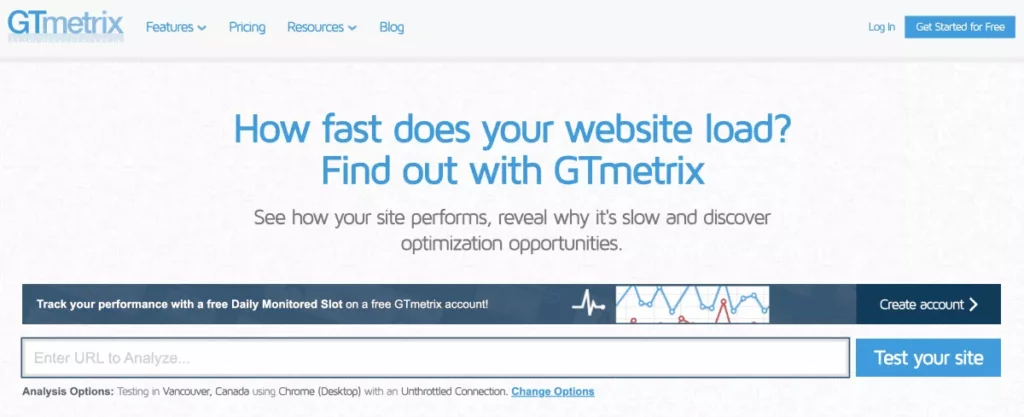
Unlike PageSpeed Insights, GTmetrix provides valuable information about the testing location, making it a valuable tool for businesses targeting national or regional audiences. It goes beyond simple analysis by delivering comprehensive reports for the analyzed website.
While unregistered users are unable to select the testing location, signing up for a free GTmetrix account grants you access to a variety of locations and testing conditions. Paying customers enjoy even more choices and flexibility.
Regardless of your chosen testing parameters, GTmetrix is an excellent tool for assessing site speed. It evaluates websites and provides the following data:
- GTmetrix grade: A weighted average of the Performance and Structure metrics, represented by a letter grade ranging from A to F.
- Web Vitals: A set of core metrics that assess website loading speed and overall performance.
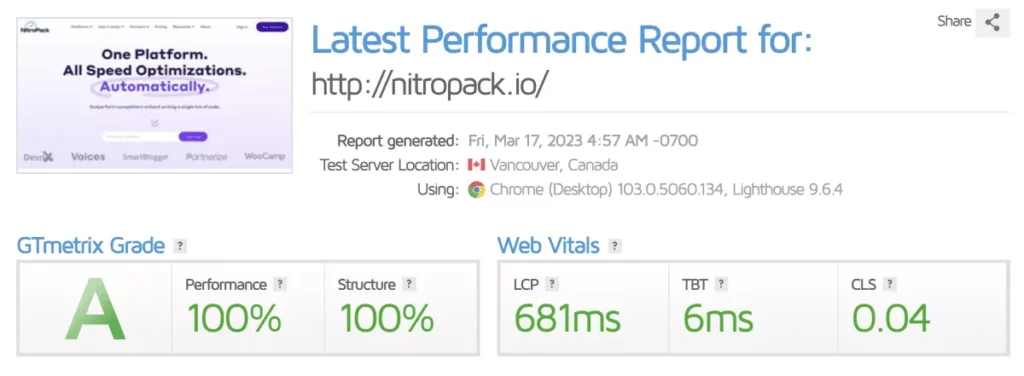
These indicators offer a strategic overview, but GTmetrix’s utility lies in its comprehensive analysis of a website’s performance. The website assessment includes the following:
- Speed visualization: Provides a visual representation of the page loading process, from the initial request to the fully loaded page.
- Identification of main issues that slow down the website, along with suggestions on how to address them.
- Breakdown of the total page size into JavaScript, Fonts, CSS, HTML, images, and other components.
- Total number of requests made by the webpage.
- Complete website waterfall: A detailed visualization of each request made during the webpage analysis.
- Retest and compare features: Crucial for measuring progress and comparing your business’s performance against competitors.
- PDF reports: Useful for web design agencies to inform their clients about the website’s performance.
Pros:
- Customizable testing conditions
- Comprehensive site evaluation
- Relevant details and suggestions
Cons:
- May be too complex for less experienced users
Price:
- GTmetrix follows a freemium model with multiple pricing tiers.
- The cheapest plan starts at $128/year.
4. WebPageTest
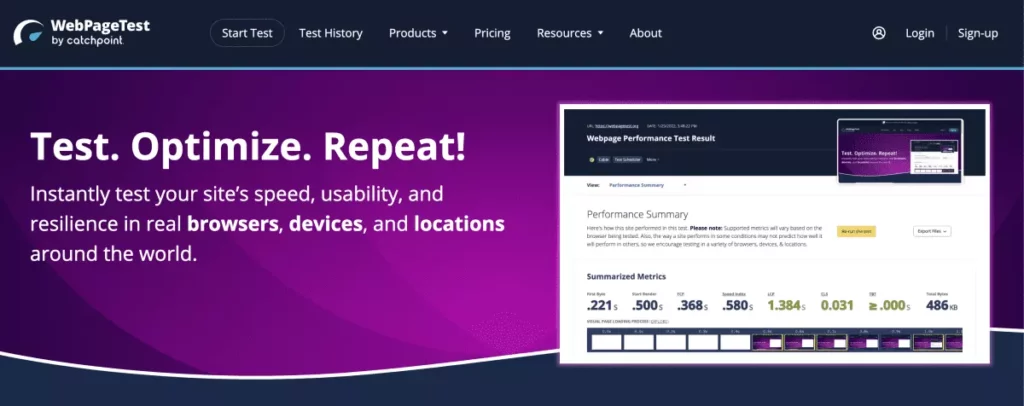
WebPageTest is an ideal tool for advanced users seeking an extensive range of features to test a website. Surprisingly, its intuitive interface also caters to less experienced users, making it a rare gem that satisfies both experts and beginners.
WebPageTest offers impressive capabilities for testing various aspects of a website:
- Site performance: Evaluate the overall performance of your website.
- Core web vitals: Measure the key metrics that assess the user experience, such as loading speed and interactivity.
- Lighthouse: Utilize the Lighthouse tool to conduct comprehensive audits and receive detailed reports on your website’s performance, accessibility, best practices, and SEO.
- Visual comparison: Compare the visual rendering of your web pages across different devices and browsers.
- Traceroute: Analyze the network path taken by your website’s requests to identify potential bottlenecks and latency issues.
Regardless of the type of test you choose, WebPageTest excels in providing a vast amount of data about your website’s performance.
Moreover, the tool offers multiple options to customize the testing environment according to your needs. You can select from 30 testing locations, 30 types of browsers, various connection types (2G, 3G, 4G, cable, Dial-up), adjust desktop browser dimensions, and specify the number of tests to run.
Although WebPageTest is not primarily designed as an SEO tool, it remains an excellent choice for conducting a comprehensive speed audit. Additionally, it offers a premium plan that provides advanced features like private and bulk testing, API access, third-party integrations, and dedicated support.
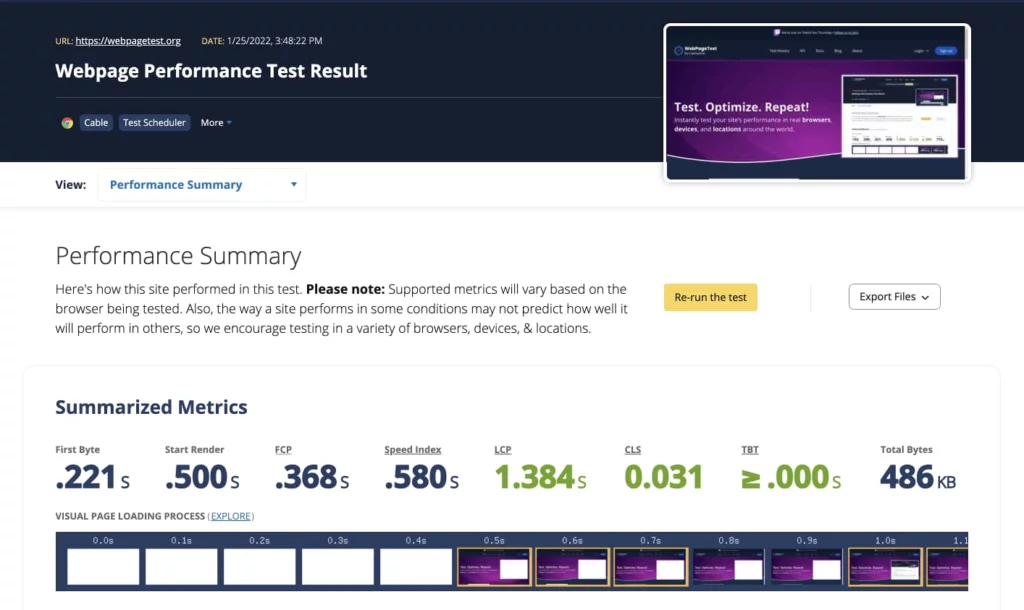
Pros:
- Customizable testing conditions
- Professional site evaluation
- Useful suggestions
Cons:
- May be too complex for less experienced users
Price:
- The pricing information for WebPageTest is currently unavailable.
5. Pingdom
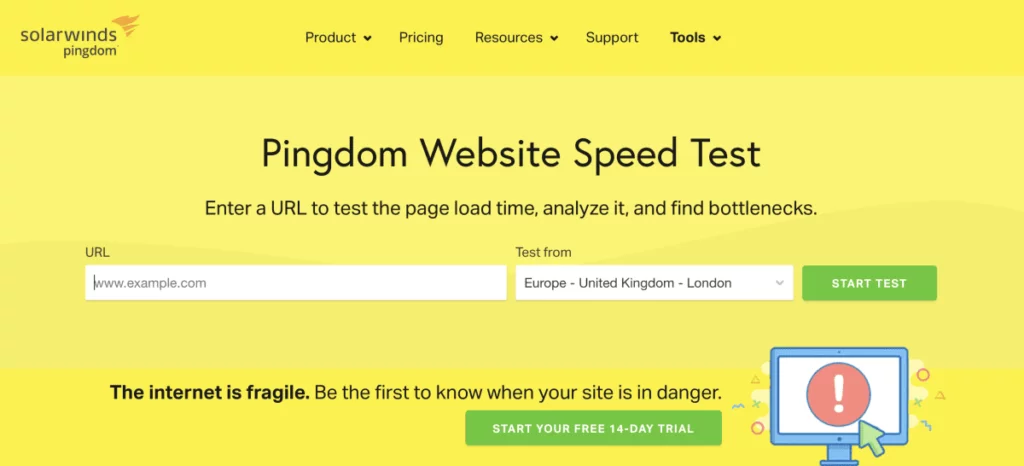
Pingdom is the perfect choice for individuals seeking a simple yet effective tool to measure the speed of their websites. With Pingdom, all you need to do is enter your website’s URL, select the desired testing location, and click the “Start Test” button.
Pingdom focuses on four key aspects to evaluate your website:
- Performance grade: Provides a grade ranging from A to F, indicating the overall performance of your website.
- Page size: Shows the size of your web page in kilobytes.
- Load time: Measures the time it takes for your page to fully load.
- Number of requests: Displays the total number of requests made by your website to load all its elements.
In addition to this data, Pingdom offers a few helpful tips for improving your website. It also provides information about response codes and content size categorized by content type. With its straightforward approach and absence of complex graphs or excessive recommendations, Pingdom is particularly suitable for less-experienced webmasters.
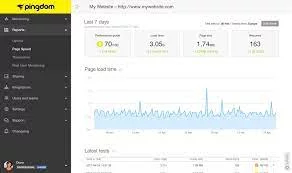
Pros:
- Simple to use
- Multiple testing locations
Cons:
- Not suitable for comprehensive site assessments
Price: Free of charge
6. Site Checker Pro

Site Checker Pro is a comprehensive tool that covers all aspects of site performance and search ranking improvement. It conducts professional speed and SEO audits, presenting the results in a user-friendly format that any webmaster can understand. This tool integrates a page speed tester with advanced website analysis capabilities.
However, Site Checker Pro offers much more than that. It is a complete SEO auditing solution that enables you to craft a strategy for enhancing your website’s ranking based on the audit findings.
To begin, create a new project for your website in Site Checker Pro. It will audit your site and provide insights into its current state. The tool highlights critical aspects, warnings, opportunities, and notices. Reducing the number of critical aspects is crucial, and fortunately, Site Checker Pro offers a plethora of suggestions to resolve any issues. The Rank Tracker feature assists in identifying the keywords for which your site performs best.
For a more in-depth analysis of your site’s most important web pages, the On-Page Checker comes in handy. It considers all on-page SEO elements, allowing you to improve individual webpages.

Pros:
- Suitable for complex SEO audits
- User-friendly interface
Cons:
- Price may be too high for those on a tight budget
Price: Site Checker Pro offers multiple pricing tiers, with the cheapest plan starting at $490 per year.
7. Uptrends Free Tools

Uptrends Free Tools offers a premium service, but its price may be a limiting factor for webmasters on a tight budget. However, Uptrends Free Tools provides a reliable and cost-free alternative to Site Checker Pro.
With Uptrends Free Tools, you gain access to several valuable services without having to spend a penny. These services include:
- Website speed test: Evaluate the speed and performance of your website.
- Mobile website speed: Test how your website performs on mobile devices.
- Core web vitals: Assess the core metrics that impact the user experience and loading speed of your website.
- Uptime check: Monitor and verify the availability of your website.
- Ping test: Measure the response time between your server and a specific location.
- CDN performance check: Evaluate the performance of your content delivery network (CDN).
- Cloud cost ROI calculator: Calculate the return on investment (ROI) for your cloud infrastructure costs.
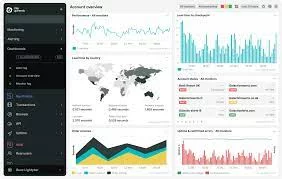
The names of these services are self-explanatory, and using them is incredibly simple. While they may not offer the depth and comprehensive analysis of a professional SEO audit, they are more than adequate for basic verification of your website’s performance and SEO status.
Pros:
- Simple to use
- Provides useful data for basic SEO and speed audits
Cons:
- None mentioned
Price: Free of charge
Conclusion:
Fast-loading website is not just a luxury but a necessity in today’s fast-paced digital world. By prioritizing website speed and continuously monitoring and optimizing your WordPress site, you can attract more visitors, improve engagement, boost conversions, and establish a strong online presence. Investing in speed optimization yields numerous benefits, including improved user satisfaction, increased traffic, and greater business success. Embrace the importance of website speed and reap the rewards of a fast and efficient online presence.
Learn about top website development platforms here.
FAQs on Website Speed Monitoring:
How often should I perform speed tests on my WordPress site?
It is recommended to regularly perform speed tests on your WordPress site, especially after making significant changes or updates. This helps you monitor the impact of your optimizations and ensures that your website maintains optimal performance over time.
Can I improve the speed of my WordPress site without technical expertise?
Yes, there are various optimization techniques and plugins available that can help improve the speed of your WordPress site without requiring extensive technical expertise. However, for more advanced optimizations or troubleshooting, it may be beneficial to consult a professional or seek assistance from experienced developers.
Is speed optimization a one-time process for a WordPress site?
No, speed optimization for a WordPress site is an ongoing process. As your site evolves and new content is added, it’s important to regularly assess and optimize its performance. Continuous monitoring, periodic speed tests, and implementing best practices will help maintain a fast and efficient website.
Remember, optimizing the speed of your WordPress site is crucial for delivering a positive user experience, improving search engine visibility, and achieving your online goals. Stay proactive and prioritize speed optimization to ensure your website performs at its best.



